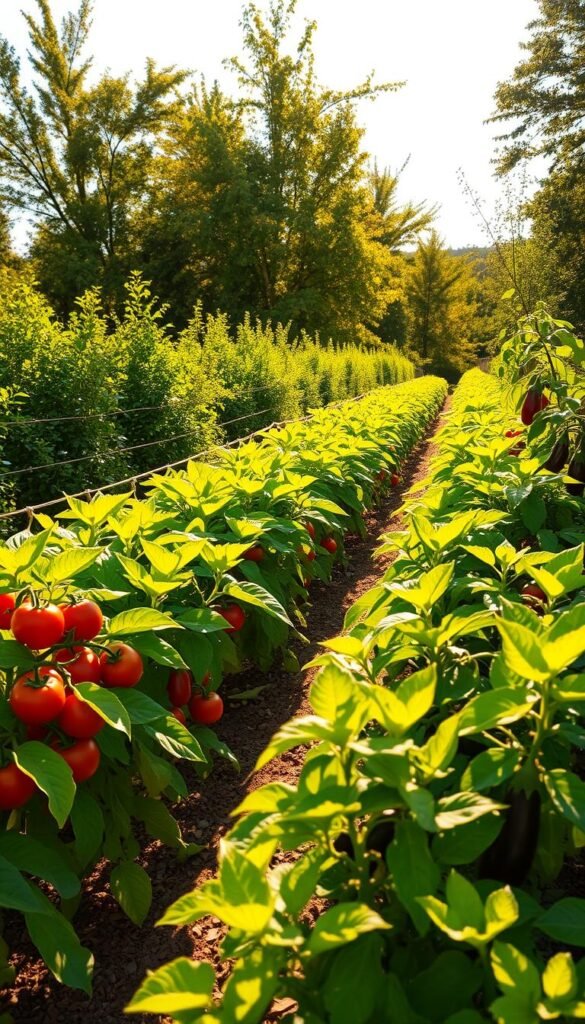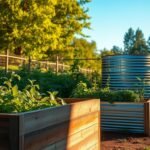When temperatures climb above 85°F for weeks on end, many crops face serious challenges. Traditional favorites like tomatoes and cucumbers often wilt or stop producing, even with careful care. But what if you could grow a vibrant, productive space that thrives when others struggle?
This guide reveals practical methods to help your green space flourish during intense warmth. You’ll learn how to pick resilient crops naturally suited to hot climates—varieties that produce abundant harvests instead of barely surviving. We’ll also share hydration techniques that protect your plants without wasting resources.
Did you know soil quality plays a huge role in heat management? Proper preparation helps roots stay cool and access moisture more effectively. For those with limited space, container solutions offer flexibility while avoiding common urban heat traps. Whether you’re selecting resilient crops or timing your plantings perfectly, we’ve got you covered.
You’ll discover how to extend your growing season through the warmest months while avoiding common pitfalls. Let’s transform those sunny days into your greatest gardening advantage!
Understanding Summer Vegetable Garden Challenges
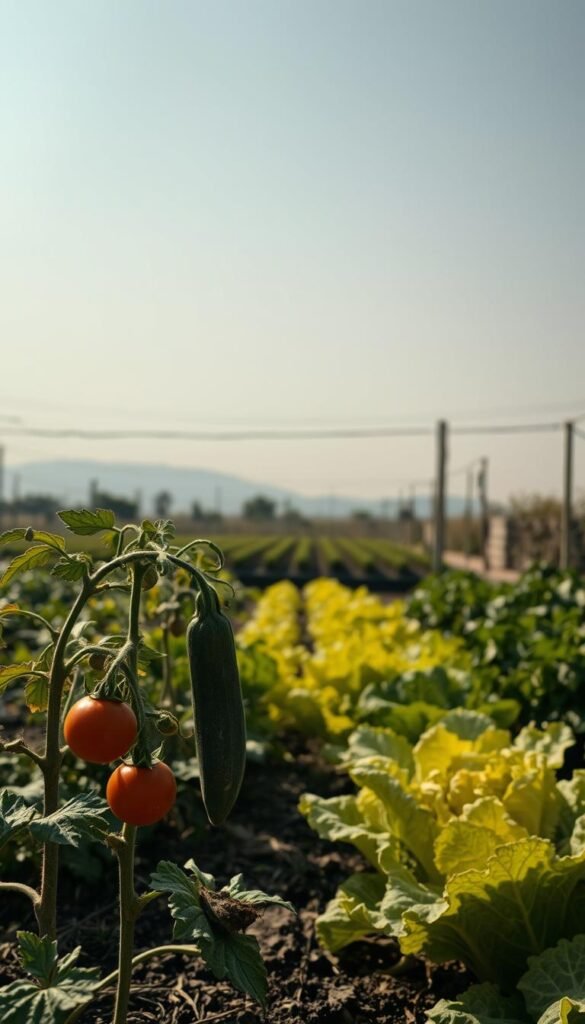
Growing in hot weather isn’t just about survival—it’s about knowing your plants’ limits. While bright days seem perfect for growth, certain conditions push common crops beyond their comfort zone. Let’s explore what happens when the mercury rises too high.
When Heat Becomes a Barrier
Your green friends need cooler nights to bounce back from scorching days. If temperatures stay above 75°F after sunset, plants can’t recover properly. Daytime highs over 90°F often stop fruit formation entirely—even tomatoes might keep growing leaves but never produce.
Watch for these red flags:
- Leaves curling inward during peak sunlight
- Flower buds dropping before opening
- Slow or uneven ripening of existing produce
Spotting Thirst Before It’s Too Late
Plants whisper their needs through subtle changes. Temporary midday drooping is normal, but persistent wilting signals trouble. Check soil moisture two inches deep—if it’s dry, your watering routine needs adjustment.
Look for:
- Crispy leaf edges despite regular watering
- New growth appearing smaller than usual
- Fruit developing sunken spots or cracks
Remember: Consistent heat changes how plants drink. Their roots work harder to absorb water, so shallow watering won’t cut it. Adjust your approach as the season progresses to stay ahead of stress.
Selecting the Right Heat-Tolerant Varieties
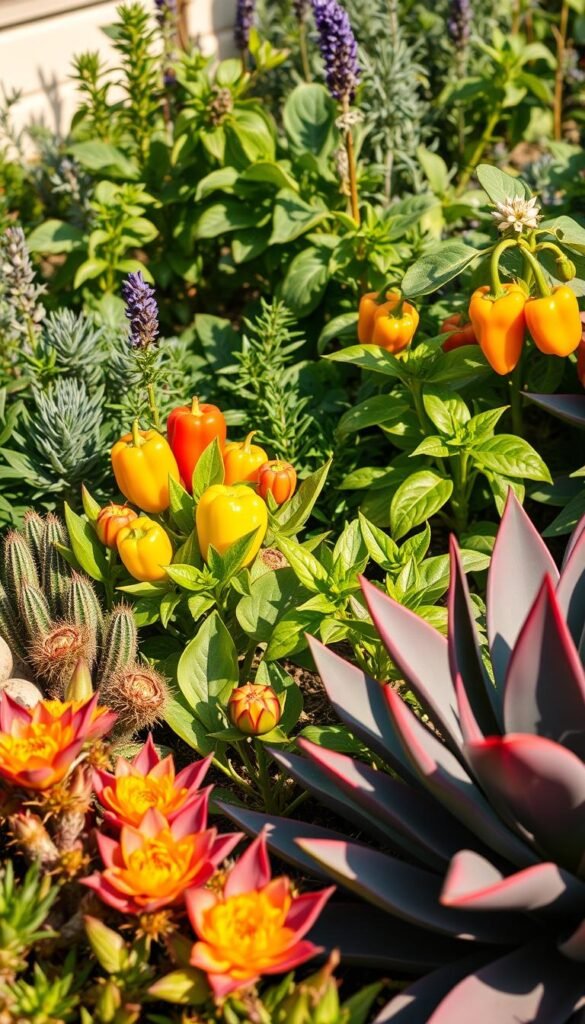
Choosing plants that naturally thrive under intense sun makes your growing efforts more rewarding. The secret lies in matching your selections to local conditions while maximizing productivity.
Vegetables That Love the Heat
Sweet potatoes dazzle with vibrant vines and purple blooms while yielding massive roots—just 16 slips can produce 40 pounds. For constant harvests, hot pepper varieties like jalapeños or habaneros outproduce others even during heatwaves.
Cowpeas adapt brilliantly, offering three harvest stages: tender pods, shelled peas, or dried beans. Yard long beans serve dual purposes—their sweet pods flourish in scorching weather, and their vines create cooling shade.
Don’t overlook okra’s reliability; its rapid pod development handles temperature swings better than most crops. Asian eggplant types also shine, producing slender fruits with creamy texture and minimal bitterness.
Fruits and Herbs for Warm Climates
Basil and rosemary flourish when thermometers spike, releasing intense aromas under full sun. Pineapple sage adds tropical flair with edible flowers that attract pollinators.
For fruiting options, consider figs—their leathery leaves resist wilting, and sweet fruits ripen despite high humidity. Melons like ‘Sugar Baby’ watermelon develop exceptional sweetness when nights stay warm.
Summer Vegetable Garden: Heat-Tolerant Varieties and Watering Tips
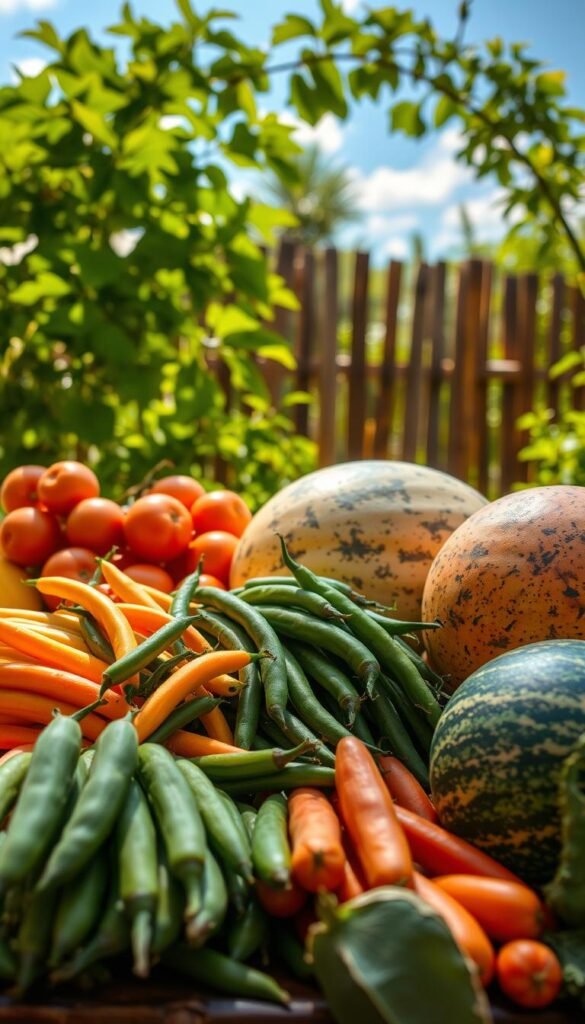
Certain crops not only survive but thrive when others falter under the sun’s relentless gaze. Let’s explore standout performers that turn scorching days into bumper harvests.
Smart Picks for Productive Harvests
Green beans give you flexible options. Bush types work well for quick yields—they’re compact and ready in 50 days. Pole varieties climb vertically, saving space while producing all season. Check out this comparison:
| Type | Growth | Harvest Window | Disease Resistance |
|---|---|---|---|
| Bush Beans | 12-24″ height | 2-3 weeks | Moderate |
| Pole Beans | 6-8′ vines | 6-8 weeks | High |
Sweet corn loves warmth but demands consistent moisture. Go for varieties like ‘Kandy Korn’—their kernels stay tender even during dry spells. Pair them with cucumbers trained on trellises; their leaves create natural shade for soil.
Melons become superstars in heat. Three Sugar Baby vines can yield enough fruit to fill a wheelbarrow. Their thick rinds protect against sunscald, while sweet flesh matures faster than larger varieties.
Don’t overlook Persian cucumbers. These crispy gems handle humidity better than standard types, producing straight fruits perfect for salads or pickling.
Watering Strategies for a Hot Season Garden
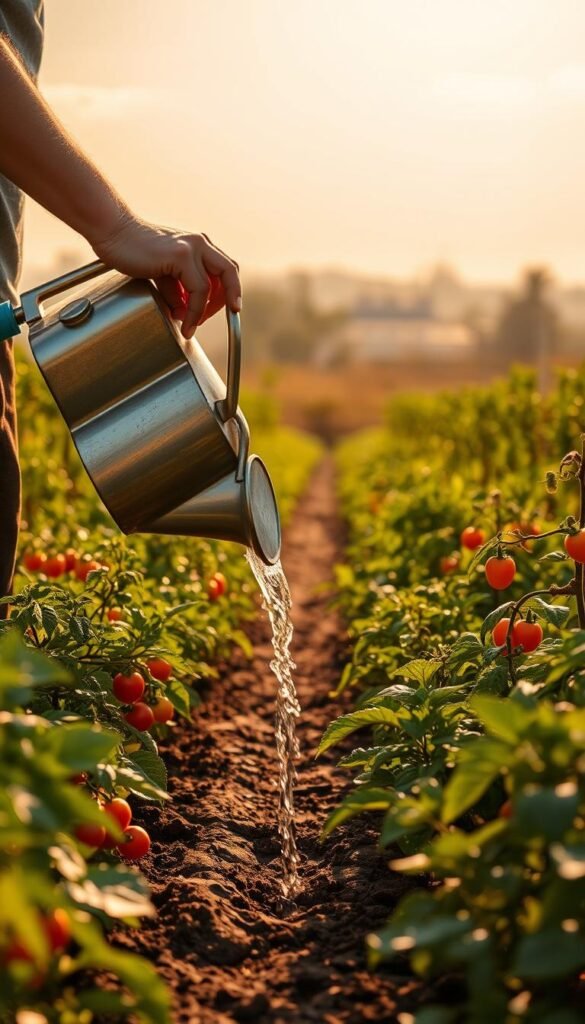
Keeping your green space hydrated during heat waves requires smart planning. Timing and technique matter more than quantity when temperatures soar. Let’s explore how to quench your plants’ thirst without wasting resources.
Morning Watering Routine
Start your day by hydrating crops before the sun climbs high. Early sessions give roots time to absorb moisture while reducing evaporation by up to 50%. Focus on soaking the soil deeply—this encourages stronger root systems that withstand dry spells.
Shallow-rooted varieties like beans need extra attention. Check soil moisture daily by sticking your finger two inches down. If it feels dry, give them a generous drink. Mulch around these plants to lock in dampness and prevent rapid drying.
Efficient Irrigation Methods
Drip systems deliver water straight to root zones through tiny emitters. They’re perfect for tomatoes and peppers, keeping leaves dry while using 30% less water than sprinklers. Soaker hoses work similarly, releasing moisture slowly along their length.
Timer systems ensure consistency during busy weeks. Pair them with moisture sensors to avoid overwatering. Pro tip: Water in short cycles if your soil drains quickly—this prevents runoff and helps liquids penetrate deeper.
Make sure your setup adapts as plants grow. Young seedlings need gentle sprays, while mature crops benefit from longer soak times. Adjust flow rates monthly to match changing weather patterns and root depths.
Soil Preparation and Organic Amendments
Healthy soil acts as your garden’s natural air conditioner, protecting roots from scorching temperatures. Start by mixing 3-4 inches of compost into the top 12 inches of earth—this creates a nutrient-rich base that holds moisture like a sponge.
Building a Strong Foundation
Root crops like carrots demand loose, crumbly earth. Work your soil deeply to remove rocks and clumps, aiming for a pH between 6.0 and 7.0. For heavy feeders like corn, add aged manure before planting—they’ll devour the nitrogen during early growth spurts.
Try this feeding schedule:
- Week 1: Mix compost into planting holes
- Week 4: Apply organic fertilizer (5-5-5 ratio)
- Week 8: Side-dress with worm castings
Mulch Magic
A 3-inch layer of straw or shredded leaves keeps soil temperatures stable. This blanket slows evaporation and blocks weeds that steal nutrients. Coconut coir works wonders in humid areas—it resists mold while improving texture as it breaks down.
Compare these soil preferences:
| Crop | Soil Type | Key Nutrient |
|---|---|---|
| Carrots | Sandy loam | Potassium |
| Corn | Clay loam | Nitrogen |
Pro tip: Test your soil every spring. Adjust amendments based on results to maintain ideal growing conditions through heat waves.
Container Gardening and Small Space Solutions
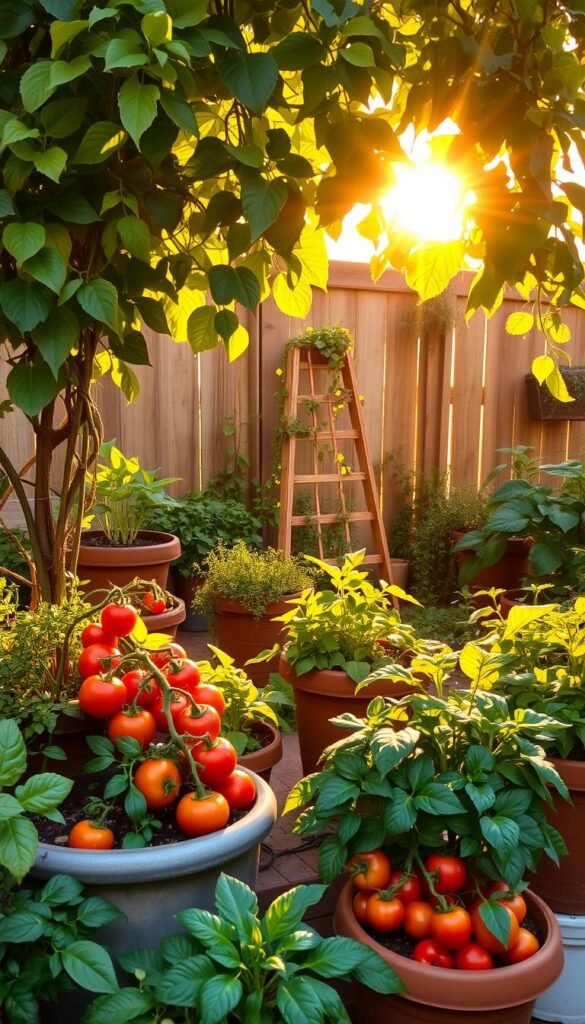
Limited square footage doesn’t mean sacrificing productivity. With smart strategies, you can turn balconies, patios, or narrow plots into lush growing zones. Containers give you control over soil quality and sun exposure—a game-changer when battling intense warmth.
Mastering Portable Plant Homes
Raised beds and pots heat up faster than ground soil, letting you jumpstart your season. But this advantage demands vigilance—check temperatures daily with a soil thermometer. 5-gallon containers work best for peppers and eggplant, giving roots room to stretch while retaining moisture.
Try these space-smart setups:
| Container Type | Best For | Soil Depth |
|---|---|---|
| Fabric Pots | Tomatoes, zucchini | 12-18″ |
| Window Boxes | Lettuce, herbs | 6-8″ |
| Vertical Planters | Strawberries, greens | 4-6″ |
Leafy greens thrive in movable pots. Shift them to shaded areas during afternoon peaks, then back to morning sun. Pair vertical trellises with vining beans—their leaves create cooling canopies for shade-loving plants below.
“Containers let you outsmart the weather—rotate plants like chess pieces to match their needs.”
For consistent results, water deeply at dawn and use moisture-retaining mixes. Coconut coir or perlite blends prevent soggy roots while surviving heat spikes. Remember: small-space gardening rewards creativity more than acreage.
Incorporating Shade and Companion Planting
Smart gardeners know that sunlight management can make or break warm-season harvests. By blending strategic shade with thoughtful pairings, you create microclimates where all your green friends flourish together.
Sunlight Partnerships That Work
Tall climbers become natural parasols for delicate crops. Try training yard-long beans on teepee structures—their lush foliage shelters radishes and bush beans from harsh afternoon rays. This living canopy cools soil temperatures while letting filtered light through.
Leafy greens reveal their true potential when shielded from peak sun. Lettuce and kale grown in dappled shade stay tender longer, avoiding the bitter taste caused by heat stress. Pair them with sunflowers, which tower above while attracting bees to pollinate nearby crops.
Arrange taller specimens on the south and west sides of your plot. This positioning blocks intense light during critical hours while allowing morning sun to reach all plants. Herbs like basil add bonus benefits—their fragrant leaves deter pests while casting protective shadows.
“Companion planting is like matchmaking for plants—find pairs where one’s strength becomes the other’s shelter.”
Check out these winning combinations:
| Protector Plant | Sheltered Crop | Bonus Benefit |
|---|---|---|
| Sunflowers | Cucumbers | Pollinator attraction |
| Corn | Spinach | Wind protection |
| Okra | Bush beans | Pest reduction |
Remember: Successful shade systems balance light exposure throughout the day. Observe how shadows move across your space and adjust plant placements accordingly.
Overcoming Pests and Heat-Related Diseases
Scorching temperatures bring more than wilted leaves—they invite unwelcome guests to your green space. Proactive strategies keep pests and diseases from hijacking your harvests, especially when plants face double threats from bugs and baking heat.
Preventive Measures for a Healthier Garden
Start by shielding vulnerable crops like squash from vine borers. In Central Texas, delaying plantings until June reduces infestations—these pests peak earlier in summer. Use lightweight row covers during early growth stages, removing them briefly for hand pollination since squash rely on insects to transfer pollen between male and female flowers.
- Space plants for airflow—crowding traps humidity that fuels fungal issues
- Water at soil level using drip irrigation to keep leaves dry
- Remove damaged leaves immediately to prevent disease spread
Boost pollinator visits by planting marigolds or zinnias nearby. Their bright blooms attract bees critical for fruit development in peppers and melons. For early signs of trouble, identify heat stress before pests exploit weakened plants.
Organic Pest Control Options
When invaders strike, fight back without harsh chemicals. Introduce ladybugs to devour aphids, or plant basil near tomatoes to repel hornworms. Try this comparison of natural solutions:
| Method | Best For | Application Tip |
|---|---|---|
| Neem oil spray | Squash bugs, beetles | Apply at dusk to avoid leaf burn |
| Diatomaceous earth | Crawling insects | Reapply after rain |
| Companion planting | Peppers, leafy greens | Use marigolds as border plants |
For stubborn vine borers, slice affected stems lengthwise with a razor blade to remove larvae—then bury the stem section to encourage new roots. Gardeners in humid areas should spray compost tea weekly to strengthen plant defenses against mildew and blight.
Seasonal Planting Timelines and Regional Considerations
Timing is everything when working with nature’s clock in warm climates. Your success hinges on syncing planting dates with local patterns—what thrives in Arizona’s dry heat might struggle in Georgia’s humidity. Start by tracking your area’s last frost date and average soil warmth using a soil thermometer.
Heat Wave Planting Strategies
In regions with 60-90 days of intense warmth, swap traditional picks for resilient alternatives early. Coastal areas like the Pacific Northwest need soil above 50°F for crops—wait until mid-May in places like Willamette Valley. Short hot spells? Interplant quick-growing okra or cowpeas between existing rows for continuous harvests.
Customizing for Your Climate
Adapt your approach using these regional tips:
Long seasons: Commit fully to heat-lovers like sweet potatoes. They’ll outproduce standard crops once temperatures stabilize.
Cool nights: Maximize warm days with melons and peppers, but protect young plants if nights dip below 55°F.
Humid zones: Choose mildew-resistant beans and train vines upward for airflow. Pair with basil to deter pests naturally.
Your planting calendar becomes a roadmap when aligned with local weather quirks. Observe microclimates in your space—south-facing walls radiate heat, while shaded corners extend leafy greens’ productivity. With smart timing and climate-aware choices, you’ll turn challenging conditions into your greatest ally.
